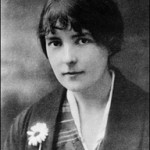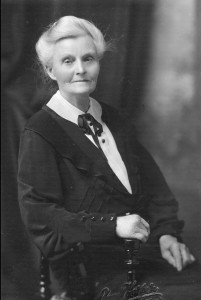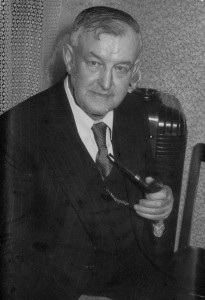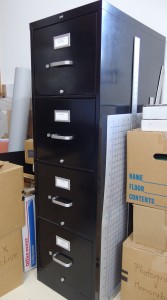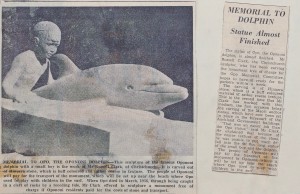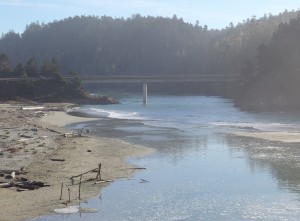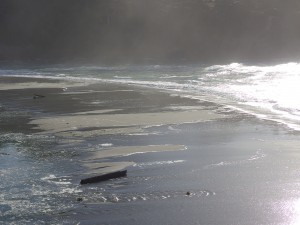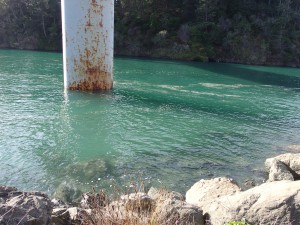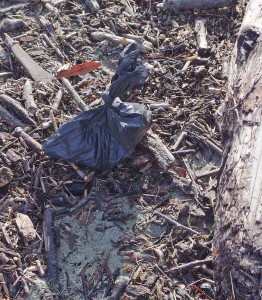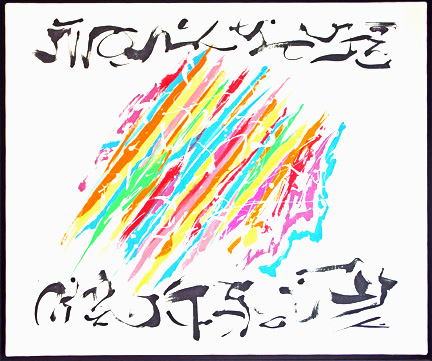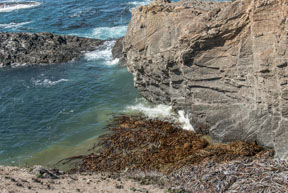Archive for the ‘sea’ Category
Scrabble and other equatorial diversions
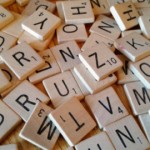 “This shipboard life is curiously hypnotic,” I wrote to my parents a few days out from Wellington in February of 1962. “Absolutely nothing to do all day but sit & watch the waves go by. You soon find it practically impossible to do any thing else.” The ‘what else’ we found as we sailed for two weeks across the tropical Pacific was the game of Scrabble. Every afternoon we gathered on the deck with a group of shipmates, one of whom had a Scrabble game in her luggage. While the nautical miles accumulated, we bonded over the game, and have continued to stay in touch with some of them over the many years since.
“This shipboard life is curiously hypnotic,” I wrote to my parents a few days out from Wellington in February of 1962. “Absolutely nothing to do all day but sit & watch the waves go by. You soon find it practically impossible to do any thing else.” The ‘what else’ we found as we sailed for two weeks across the tropical Pacific was the game of Scrabble. Every afternoon we gathered on the deck with a group of shipmates, one of whom had a Scrabble game in her luggage. While the nautical miles accumulated, we bonded over the game, and have continued to stay in touch with some of them over the many years since.
After the storms and seasickness of the first week, we had perfect weather: sunny days, calm seas, and just enough breeze to keep things cool. I decided that ocean voyages were not so bad after all.
I had time to dream. When my husband Tony and I carried our bags up the gangplank of the “Johan van Oldenbarnevelt” earlier that month, bound for New York and then England, I felt I was walking in the steps of my role model, the great New Zealand writer Katherine Mansfield, who also went abroad at a young age to pursue a literary career.
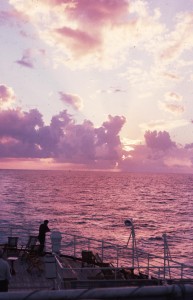 As the familiar constellations of the Southern Hemisphere receded southward, we discovered the truth of Samuel Taylor Coleridge’s lines in “Rime of the Ancient Mariner:”
As the familiar constellations of the Southern Hemisphere receded southward, we discovered the truth of Samuel Taylor Coleridge’s lines in “Rime of the Ancient Mariner:”
The Sun’s rim dips; the stars rush out;
At one stride comes the dark
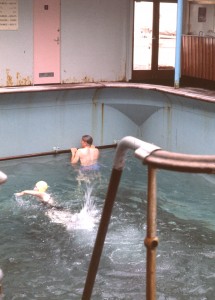 My letters comment on the group of people we got to know: “… Mainly the crowd from our table. We have had some very good discussions and arguments about all sorts of things. The brain needs some exercise after sitting looking at the sea most of the day. So does the body – we are getting good at deck tennis (our own rules), and have spent quite a bit of time in the swimming pool. When the sea was rough the water in it sloshed back and forth terrifically, but is better now.”
My letters comment on the group of people we got to know: “… Mainly the crowd from our table. We have had some very good discussions and arguments about all sorts of things. The brain needs some exercise after sitting looking at the sea most of the day. So does the body – we are getting good at deck tennis (our own rules), and have spent quite a bit of time in the swimming pool. When the sea was rough the water in it sloshed back and forth terrifically, but is better now.”
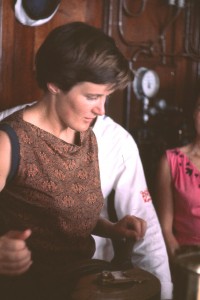 A few highlights of the voyage float into my mind. A visit to the bridge, where I was allowed to steer the ship. Watching flying fish and dolphins leap out of the water close to the ship. The obligatory visit from King Neptune the day we crossed the equator. But mostly I remember playing Scrabble on deck with our new friends, while Indonesian stewards in white jackets rattled tea-trolleys.
A few highlights of the voyage float into my mind. A visit to the bridge, where I was allowed to steer the ship. Watching flying fish and dolphins leap out of the water close to the ship. The obligatory visit from King Neptune the day we crossed the equator. But mostly I remember playing Scrabble on deck with our new friends, while Indonesian stewards in white jackets rattled tea-trolleys.
I haven’t played Scrabble in years, and don’t remember what happened to our old game set. But this week we bought ourselves a new one. Nostalgia filled my heart as I pulled out from the bag a handful of little wooden tiles.
JVO photographs are by Tony Eppstein.
Maureen is exploring the contents of an old black filing cabinet, which contains 55 years of letters, notes and memorabilia.
Hurricane at Sea
We skirted a hurricane (known as a cyclone in the South Pacific) for the first several days after my husband Tony and I left Wellington, New Zealand, bound for New York on the “Johan von Oldenbarnevelt.” For most of that time I lay on my bunk, so seasick I wished I were dead just to get the misery over with. In a letter to parents I scrawled: “Mountainous heaps of water piling up all over the place, wind changing direction all day …Steady old JVO bobbing around like a cork. Thank goodness I have got my sea legs at last – after the first few days of utter misery in a very stuffy cabin. Am still on a largely dry bread and water diet – lost a terrific lot of weight. But have been reading Women of New Zealand today and decided that my lot is not too bad after all. What those women had to put up with on their voyage out to NZ makes me feel rather ashamed of myself.”
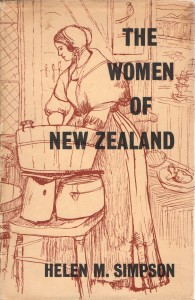 The book I referred to, The Women of New Zealand by Helen M. Simpson, had been a parting gift from my parents, who had come to Wellington to see us off. First published in 1940, it was a vivid description of the lives of pioneer women.
The book I referred to, The Women of New Zealand by Helen M. Simpson, had been a parting gift from my parents, who had come to Wellington to see us off. First published in 1940, it was a vivid description of the lives of pioneer women.
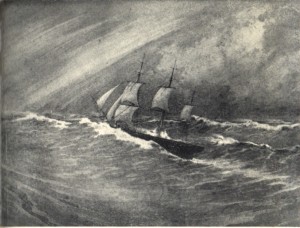
The Ship “Kenilworth” Outward Bound for New Zealand. An illustration in Helen M. Simpson’s The Women of New Zealand, it is a reproduction of a painting by J.C. Richmond, now in the possession of the National Art Gallery, Wellington.
An early chapter describes conditions on board the emigrant ships for the four- to six-month journey from the British Isles to New Zealand. Simpson comments: “Cramped quarters ashore are difficult enough to deal with; at sea, when with every lurch of the ship ‘all things animate and inanimate’ were hurled about, children and chairs in terrifying and noisy confusion …”
Our quarters on the JVO were certainly cramped. Our lower-deck cabin had two bunks and a tiny washbasin in a space so narrow we had to take turns getting dressed. Outside in the corridor, the airless heat was rank with smells from the nearby galley. But unlike those early emigrants, we didn’t have to cook for ourselves, or bring along our own cabin furnishings.
I think of my own ancestors who braved the outward journey. A hundred years before Tony and I walked up the JVO’s gangplank, my newly-married great-great grandparents, Bernard and Sarah Donnelly, set out from County Leitrim in Ireland to join hundreds of other Irish immigrants on the New Zealand goldfields. My paternal grandfather, Charles Dinsdale, emigrated from Yorkshire, England in the early 1900s. By then steam had replaced sail, but he would have set out for his new life half-way across the world with the same sense of adventure.
In her book, Simpson tells of a shipboard fire, when passengers & crew took to the lifeboats. A woman passenger wrote that, when told of the fire, ‘I folded up my knitting, put on my bonnet and shawl, and went up.’ Simpson comments: “So figuratively hundreds of other women folded up their knitting, and, putting on bonnets and shawls, quietly faced these and other perils, and all the acute discomforts of the long voyage to the new land where their hopes rested. Dangers and discomforts were accepted without fuss.”
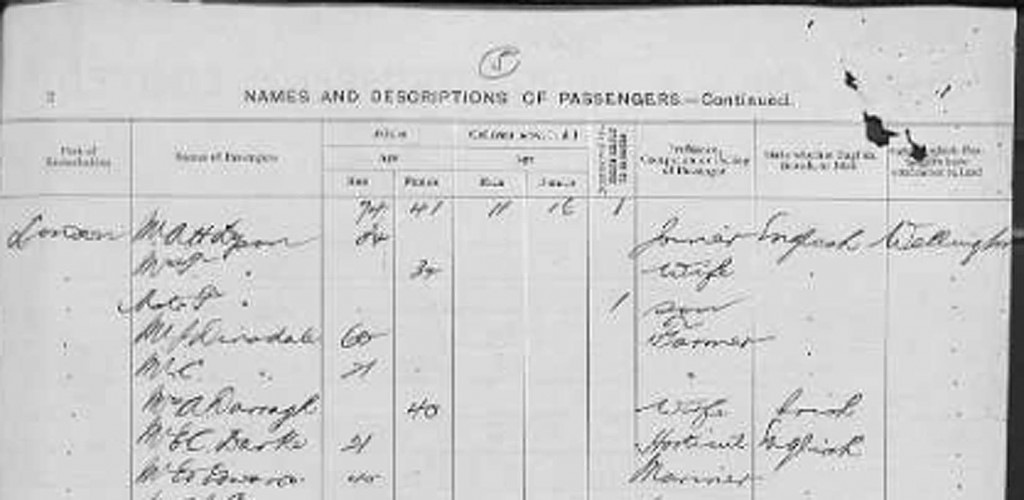
Passenger list for the SS “Corinthic” 1904. The 21-year-old C. Dinsdale (fifth name down) is probably my grandfather. From https://familysearch.org
Simpson’s standard of appropriate behavior is typical of the New Zealand society I grew up in, where we were expected to just deal with whatever hardships came our way. This is why I felt so chagrined for feeling sorry for myself.
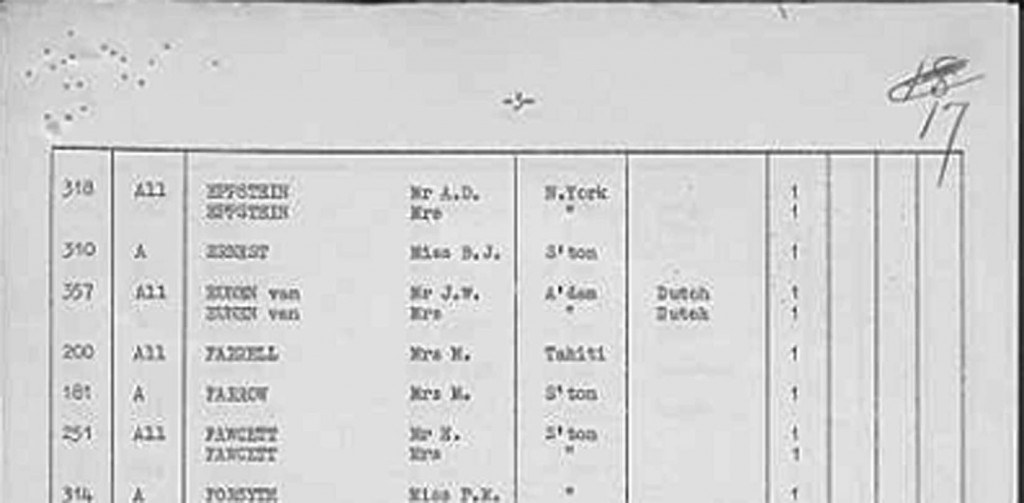
Passenger list for the “Johan van Oldenbarnevelt” 1962. Our names are at the top of the page. From https://familysearch.org
Maureen is exploring the contents of an old black filing cabinet in her attic, which contains 55 years of her writing notes and memorabilia.
Dolphins of Yesteryear
A 55-year-old news clipping brings back memories
An old black metal filing cabinet sits in my cluttered attic. Stuffed into its four drawers are fifty-five years of my stories, some published, most not. Sooner or later someone will have to dispose of all the dog-eared pages and travel-worn manuscript boxes. In the meantime, I’ve set myself a little project for this blog: go through the files and find pieces of my past that you, my readers, might find interesting.
Here’s one, to start us off. On January 6, 1960, I was fresh out of college, and this was my first day on the job as a cub reporter at The Press, Christchurch, New Zealand’s morning newspaper. My boss, the city editor, handed me a four-year-old clipping about the death of Opo, a bottlenose dolphin who chose to join children at play in the surf at Opononi, a beach settlement in the Northland region. The grieving residents had commissioned a statue. “Here, update this story,” he said. “The sculptor lives in Christchurch. His phone number’s in the book. I’ve heard he’s nearly finished.”
I had a pleasant conversation with Russell Clark, the sculptor, who was making the sculpture free of charge as his tribute to Opo. It is of Hinuera stone, which is buff colored and coarse in texture. The sculpture was indeed nearly finished, and would be shipped to Opononi the following week. I was so proud when my little story appeared exactly as written, along with a nice photograph, in the next morning’s edition, having survived unscathed the eagle eyes of The Press’s copy editors, gruff eminences who ruled from a curved dais in back of the press room.
I did not meet Opo, but have my own dolphin memory. We were returning from a family vacation on Tuhua, an island offshore from Tauranga. The day was brilliantly sunny, the launch was bouncing through waves, and I had just learned that I’d been awarded a national scholarship to attend university. A school of dolphins surrounded the boat. Leaping joyously through the waves, they escorted us back to land. As I stood at the bow, I felt like a princess.
Citizen/Science
A king tide this morning, and we’d heard that it would be useful for people to document how high the water came, so that we’d have some idea what to expect as climate change brings rises in sea level. An excellent excuse to amble down to Big River Beach in Mendocino with my new camera and practice getting my horizons horizontal.
We’ve had no major rainstorms yet this winter to wash out the sandbar that builds up at the mouth of the river. From a vantage point on the cliff, we watched the tide creep over the bar, then took the old steps down to the beach to check on the tide height at the bridge. Yes, the water was high, too high to walk on sand and touch the bridge pier, as we can usually do.
Strolling back along the tide line, we were enjoying the peace and quiet beauty of the scene when I noticed something that set my teeth on edge: a plastic dog poop bag discarded by a driftwood log. I’ve seen such offerings frequently around this region: beside a signpost, on the edge of a trail. I want to shake the humans who leave them, who are so unclear on the concept of citizenship they have no thought for the environmental mess they are causing. It’s no wonder the sea level is rising.
Texts
Searoad, a story collection by Ursula K. LeGuin, has a permanent place on my bedside table. It’s there because every now and then I need to reread a certain story. A very short story, less than three pages, it is titled “Texts,” and tells of an older woman who, bombarded by messages and calls to action, retreats to the coastal Oregon village of Klatsand for a month-long winter break. As she walks on the deserted beach, she notices that the waves have left messages in the lines of foam, messages she can almost decipher. The laciness of the foam leads her to speculate that crochet work and lace might also be legible. In a handmade lace collar she reads a message that seems directed to her: “my soul must go, my soul must go … sister, sister, light the light.” There the story ends, with the woman not knowing “what she was to do, or how she was to do it.”
I think of this oddly moving little story every time I walk on Ten Mile Beach, as I did last Sunday. The receding waves left undulating lines of bubbles, iridescent in the hazy sunlight, that popped to form patterns of foam. Scattered across the beach were strands of bull kelp, dried into coils and loops that lay like a cursive script on the sand.
Yesterday, when the wind was brisk and the sea streaked with white caps, I remembered an interview I did for the Mendocino Art Center magazine. It was part of a series I wrote on artists who helped found the art center in the 1960s. By the time I met Jim Bertram in the early 2000s, he was senile and nonverbal, so I had to rely on material in the art center archives for information about his background and artistic vision. Nevertheless, Jim and I spent a wonderful afternoon together. I think a poem I wrote at the time sums it up:
MESSAGES
For JB
“Line expresses the inner thought. It is a narrative of what we really want to tell each other but somehow can’t seem to verbalize.”
– Jim Bertram
These bright spring days, when the wind
scribbles its white calligraphy
on a wash of aquamarine,
I think of the artist in his studio
upstairs of a weathered storefront
overlooking Mendocino Bay.
Sheet after curling sheet he showed me, canvas
after canvas, covered with calligraphic forms
that could have been words, but were not.
In our shared silence I understood his drift:
how sometimes what matters most is inarticulate:
like the line of spray from a lifting wave,
the hand of an old man painting messages of love.
On my way downstairs from Jim’s studio, I fell in love with one of his paintings, which now has a place of honor in my house. I smile when I read its message.
Wave/Rock
I’m jealous of Scottish visual poet Ian Hamilton Finlay.
Last Sunday morning I walked on the cliffs at Chapman Point, just south of Mendocino. Tony, who does the graphics for Mendocino Coast Writers Conference, was taking photographs that might become next year’s program cover or a display ad in Poets & Writers magazine . I contemplated spume lifting from waves as they rolled in steady rhythm against the rocks, and thought about words I might use to convey the sense of transience that pervades this dramatic boundary between earth and sea.
Back home, I started making a list: undercut, backwash, swirl, surge, strata, submerge, carve, crevice, recede, collapse, uplift, unrest, rockfall, bull kelp, blueness, sheer … A few lines started to appear:
In the curve of the undercut
at the cliff’s base
the shape of wave
I decided to let the lines sit for a while and turned to another project. My friend Mary Marcia Casoly had recently sent a link to an anthology, Shadows of the Future: An Otherstream Anthology containing two of her poems. “Vispo,” she called them, visual poetry. Not a form I knew much about, so I Googled it and found a number of sites that had definitions and examples. Visual poetry, I learned, is “poetry that cannot suffer any translation into alternative visual or typographic form without sacrificing some of its meaning and integrity… The ‘quality of presence’ we get from the work depends on visual means, such as typefaces, format, spatial distribution on the page, or the physical form of the book or book object.” (Johanna Drucker)
I opened an example at random. Immediately my entire afternoon at my desk was washed out to sea. Before me was Ian Hamilton Finlay’s “Wave/Rock” from Aspen #7. Just two words repeated: the brown rockrockrock stacked on top of each other so that the near-vertical strata are visible; the blue wave words spread and broken as they crash against the rocks.
Edge of the Creek
High tide was at dawn. By noon, the breaking waves are far distant, and the creek on its way to the sea has cut a miniature cliff through damp sand. A reflection of sun on water ripples along the vertical face, fluted already by tiny sand-falls. As I watch, more sand avalanches skitter down to where, about half-way to the water, an undulating line with a little thickness to it, like a welted trim, defines where the vertical cliff gives way to a more gradual slope. The damp sand grains bounce off the ridged line and spread out down-slope, coming to rest at about forty degrees, their angle of repose. The scene is a microcosm of the world’s geological processes, the lifting up of land masses, the crumbling away. But what strikes me most is the beauty of it: the rippling light, the fluted cliff, the flurries of sand. I am mesmerized by pattern.
On the Haul Road
The Fort Bragg Haul Road this Saturday afternoon is like a painting of a European beach promenade. Misty silhouettes in the silvery light, family groups with dogs and bicycles take the air in the short break between storms. The sea roars. A brisk wind lifts delicate plumes of spray from the waves.
The old Haul Road is a local treasure. Built in the early 1900s to haul logs to the Fort Bragg lumber mill, it is now part of the California coastal trail system. Further north, the sea has washed away much of the road, but for close to three miles, between the Pudding Creek Trestle Bridge at the edge of town and the campground at MacKerricher State Park, it is still reasonably intact.
This afternoon, after a week of rain, people walk with smiles on their faces. The reservoirs and aquifers are filling up, ending fears of drought. More rain is forecast. Today the sky is blue and the sea magnificent.
Between Storms
Mid-morning the sky clears, a break between storms. Our generator rumbles. The power is out, a downed line somewhere back in the forest. So is our cable internet service. From the house we can see spume lifting high over the cliffs. Nothing for it but to go there, to walk the cliff path around the Mendocino Headlands, to exult in the roar, the tumble of white, the spritz of salt spray on our faces. At the big blowhole near Main Street, huge plumes of water rise with a satisfying ker-thump.
We decide to avoid the muddy parts of the trail further on, and head up to Main Street. Nearly all the stores are closed because of the power outage. But Gallery Bookshop, on the corner of Main and Kasten, is open, though unlit. We step in to say hi.
“Electricity, schmelectricity,” laughs Christie, the owner. “We never close. We just do everything on paper and input it later. We have the little swipe-swipe machine for credit cards. The only thing that’s hard to do without the computer is book searches.”
Tony finds a novel he wants, Hilary Mantel’s Wolf Hall, winner of the 2009 Man Booker Prize. At the checkstand in the center of the store we chat with Christie and two other staff members, Johanna and Jane, about this book and another we’ve been reading lately, A.S. Byatt’s The Children’s Book. I love the cosiness of these conversations about books. I love being a local in this remote and beautiful place.
